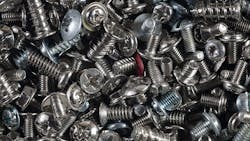A Quick Look at Steels Used for Fasteners
Fasteners are often made of steel, but there are many different types of steel. Here are the steels most commonly used for fasteners:
Alloy steels: Steels alloyed with molybdenum, nickel, and chromium (AISI 4037, 4130, 8630) are best if strength is required. These steels also have good cold-forming properties when annealed and can be heat-treated for the best combination of strength, toughness, and shock resistance.
Carbon steels: Fine-grain, fully killed (i.e., completely deoxidized) basic steel with no alloying agent. Low-carbon steels have from 0.06 to 0.22% carbon content (AISI 1008, 1010, 1018, and 1022) and exhibit good ductility for cold-forming. Medium-carbon steels contain 0.30 to 0.50% carbon content (AISI 1038, 1045) and are stronger but less ductile. These steels respond well to quench and temper. High-carbon steels contain 0.50% or more carbon (AISI 1066, 1095). They are difficult to cold-form unless annealed. They do, however, have high strength and can be heat-treated.
Hard-drawn MB spring wire, ASTM A227: Carbon content ranges from 0.60 to 0.70%. Used for general purpose low-cost springs, it is commonly available in diameters from 0.031 to 0.5 inches. It has less tensile strength than music wire.
Leaded steels: Adding lead to steel improves its machinability. Leaded steels are identified by an “L” (AISI 12L14) in their AISI/SAE designation. Lead is most commonly added to 1100 and 1200 series of screw-machine steels. Leaded steels are not suitable for heat treatment or welding. RoHS allows lead as an alloying agent to a certain level.
Music wire, ASTM A228: Carbon content varies from 0.80 to 0.95%. It has high tensile strength and withstands repeated loading. It is widely used in small diameters ranging from 0.005 to 0.125 inches.
Resulfurized and rephosphorized steels (AISI 1117 and 1215): These steels have better machinability than basic carbon steels and are commonly used for screw-machine parts. The steels are more brittle, less ductile, and stronger than basic steels with equivalent carbon content. Sulphur acts as an internal lubricant and is the major alloying agent for 1100 series steels. Phosphorus makes the steel more brittle, reducing friction, heat, and tool wear. 1200 series steels have both phosphorous and sulfur as alloys.
Stainless Steels
Austenitic stainless steels: (AISI 202, 302, 304, 316): These steels are generally nonmagnetic and have the best corrosion resistance due to their large content of nickel and chromium. Their good cold-forming characteristics are subject to work hardening and are not heat treatable.
Martensitic stainless steel (AISI 410, 420): These metals are straight chromium steels with little or no nickel. They are magnetic and can be heat-treated. They also have more strength than austenitic types, as well as lower corrosion resistance and are harder to cold form.
Precipitation hardening stainless (AISI 17-4 PH): These are nickel chromium stainless steels with cobalt and tantalum. The alloying agents produce high strength and ductility, as well as good machinability and weldability. Hardening is by aging the cold steel at 900° F for four hours followed by air-cooling. They are not used for cold-forming, but are commonly used for high-strength, corrosion-resistant screw-machine parts.
Aluminum alloys: These are obviously not steels, but are widely used for fasteners. They have good cold-forming characteristics. Many aluminums (2024, 3003, 5056, 5554, 6061, and 7075) can be used, and when secondary machining is required, 2011 aluminum is often chosen. Aluminum alloys resists corrosion and some can be heat-treated.
David Zimmermann is president of Pivot Point Inc., Hustiford, Wis.
Looking for parts? Go to SourceESB.
